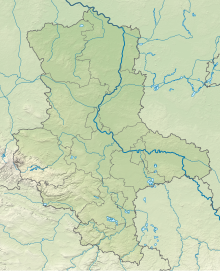Great Strict
Coordinates: 51 ° 49 ′ 37 ″ N , 12 ° 46 ′ 23 ″ E
The Große Streng is a nature reserve in the cities of Zahna-Elster and Kemberg in the district of Wittenberg in Saxony-Anhalt .
The nature reserve with the registration number NSG 0101 is around 462 hectares in size. It is part of the FFH area "Elbaue between Griebo and Prettin" and the EU bird sanctuary "Estuary of the Black Elster". The reserve is mostly from the conservation area - surrounded "Elbetal between Wittenberg and Bösewig". It has been under protection since May 1, 1961 (date of regulation: March 30, 1961). The responsible lower nature conservation authority is the Wittenberg district.
The nature reserve is located southeast of Lutherstadt Wittenberg in the Elbe River Landscape Biosphere Reserve . It comprises an open floodplain area in the Elbaue with several oxbow lakes of former meander arches of the river. In addition to two large oxbow lakes, the Old Elbe and the Großer Streng, there are other, sometimes only small, still waters in the area. The Old Elbe is connected to power the same connected. The nature reserve is located in the flooded area of the Elbe and is bordered to the south by a flood dike. At Wartenburg it borders on inland dune areas. The Fuchsberg, an inland dune in the northwest of the nature reserve, is at 77.2 meters the highest elevation of the otherwise 70 m above sea level. NN lying area.
In addition to the oxbow lakes, the nature reserve is characterized by extensive grassland areas . Meadow foxtail settles on the often intensively used grassland . In the area of the oxbow lakes, reeds from water plumes dominate , with small areas of calamus reed , marsh cress reed and arrowhead reed . Wet transition areas are occupied by slender sedge and shiny grass areas. Here u. a. Iris pseudacorus , Marsh Woundwort , Myosotis scorpioides and Common Loosestrife . In sinks and flood channels resettle flood lawn companies. Dwarf rush communities settle on mud flats, which temporarily dry out in summer, along the Old Elbe. In the oxbow lakes there is only a few floating leaf vegetation with pond rose communities and aquatic plant communities with comb spawn , streaky spawn and rough horn leaf . On the banks of the oxbow lakes, trees grow in places. In the area of the Großer Streng, alluvial forest remains can be found. A sparse stand of pines grows on the Fuchsberg. Further areas here are taken up by silver grass fields and sand sedge .
The area is the habitat of the Elbe beaver . In the nature reserve are u. a. Great crested grebe , coot , kingfisher , puffy titmouse and common boar . The rest is lowland forest habitat of Red Kite , Great Spotted Woodpecker , Lesser Spotted Woodpecker , Nightingale , Yellow Warbler and Blackcap . The mud surfaces that occur at low water levels are used by numerous Limikolen for foraging. The area is also a feeding habitat for gray herons that breed in a nearby gray heron colony. During bird migration , it is of great importance as a resting area for migrating waterfowl , which can be found especially on the "Old Elbe".
The nature reserve is bordered to the north by the Elbe. Otherwise, on the other side of the flood dike, mainly agricultural areas are adjacent. Forest communities grow in the area of the inland dunes.


